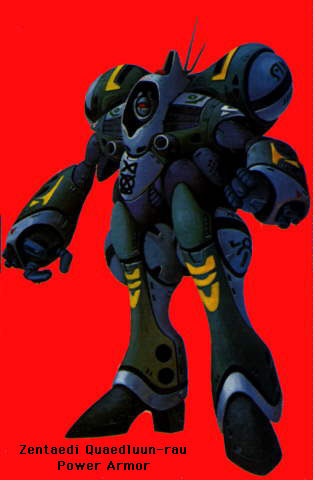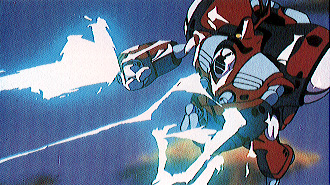

Designation:Queadluun-Rau Air/Ground Power Armor |
|
||||

|
|||||
| Length : | 10.8 m |
| Width : | 18.4 m |
| Height : | 16.8 m |
| : | 18.8 m (with antenna) |
| Weight : | 32.5 metric ton |
(*) Terran designation. The Tirolian designers considered the sensors part of the design and did not assign separate designations for these systems.

The armor of the Queadluun-Rau was composed of an advanced titanium-steel alloy. The armor stopped all small arms and heavy infantry weapons fire, provided reasonable resistance to light mecha-mounted weaponry, such as the Zentraedi 22.3mm HE autocannon round, and poor resistance to medium mecha-mounted weaponry, such as the Valkyrie's 55mm APFSDS round.
The Queadluun-Rau provided full protection from nuclear, biological, and chemical hazards, using a sealed cockpit environment. The internal consumables supplies could provide breathable atmosphere for four days maximum.
The final, and very probably most effective and finest Zentraedi mecha was the Queadlunn-Rau, literally the "Heavy Power Armor". Used almost exclusively by the female Zentraedi air corps, this battle suit was one of the last of the Zentraedi mecha to be developed, created after initial combat experience with the Disciples of Zor showed that the Nousjadeul-Ger was less suited for commando raids. This mecha was used in that role because it was the most suited at the time, but as it was originally intended as an ground cavalry mecha, it performed badly against -air or spaceborne opponents. The requirements called for a mecha with the highest possible acceleration, a very heavy armament, excellent capability as a dogfighter and performance identical to the Nousjadeul-Ger on the ground.
Fulfilling these demanding requirements did not prove simple. The large speed required large engines, which required a large frame, which in return required more engine power, and so forth. The Queadluun-Rau battle armor design eventually grow larger than the Regult battlepod, although advanced materials kept the overall weight down. However, the power demands from the engine's fusion piles made an exclusive energy weapon fit impossible, and the designers switched to a mix of cannons, missiles and energy weaponry. To improve maneuverability, the Queadluun-Rau had the most extensive attitude thruster installation ever installed. This system, known as the Inertia Vector Control System, made it possible to not only control the attitude of the mecha and engines, but also positioned the limbs. The advantage over other systems, which generally use servo mechanisms to move limbs about, is enhanced maneuverability. However, the system was relatively fragile and required a large amount of maintenance.
The chest cannons of the Queadluun-Rau were identical to the single chest Gatling cannon of the Nousjadeul-Ger. However, because of the doubled firing rate but the not quite doubled ammunition supply, the battlefield persistence of these weapons was low. In addition, these weapons, by nature and placement, were effectively useless in aerial or aerospace combat. The cannon armament was made up of six small dual-purpose particle beam, bundled into two mounts of three guns each. The firing arcs of these weapons were excellent, and the accumulative effects on a target sufficient. The pulse mode was installed as a strafing option, but was in practice little used, the pilots instead preferring to use the large missile armament against ground targets. The actual missile mounted on the Queadluun-Rau was one of the smallest ever mounted on a modern mecha, and consequently their range was restricted to what came down to point-blank. No less than 126 missiles were carried, but as tended to be used in large salvo's, the missile supply ran dry after an average of eight shots.
The Queadluun-Rau was probably the most feared of all Zentraedi mecha, Given its assault and commando mission profiles however, losses tended to be high. The mecha was expensive to construct, and though plans existed to re-equip many units (including close air support and cavalry units) with this mecha, only the more elite commando forces received shipments of these machines before the Zentraedi military machine was destroyed.
Return to Zentraedi Mecha Index.
Go to Robotech Reference Guide Home Page.
Robotech (R) is the property of Harmony Gold. This document is in no way intended to infringe upon their rights.
Content by Pieter Thomassen and Peter Walker, with Rob Morgenstern